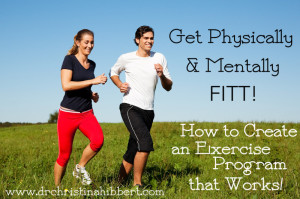Get Mentally & Physically FITT! How to Create an Exercise Program that Works
 If you want to reap all the Physical & Mental Health Benefits of Exercise you’ll need a solid exercise program. And in order to create a program that lasts and produces the results you desire, I’d like to share with you one of the best things I’ve learned in all my years as a Fitness Instructor–a principle I still use in my own life and as a Psychologist–The FITT Principle.
If you want to reap all the Physical & Mental Health Benefits of Exercise you’ll need a solid exercise program. And in order to create a program that lasts and produces the results you desire, I’d like to share with you one of the best things I’ve learned in all my years as a Fitness Instructor–a principle I still use in my own life and as a Psychologist–The FITT Principle.
The F.I.T.T. Principle
The FITT Principle is the underlying foundation of exercise, the key to exercise programs that work. F.I.T.T. stands for: Frequency, Intensity, Time, and Type. Let’s take a look at each of these components:
Frequency:
“How often should I exercise?”
The frequency will depend, of course, on your fitness level and goals. In general, 3-5 days a week is recommended for cardiovascular exercise, in order to receive optimal health benefits. When you’re just beginning a program, 3 days is a great start. Soon, you might increase to 4 or 5 days. For weight loss, you may need to exercise 6 or more days. Strength training is also recommended, 1-3 times a week, with at least one day in between to let your muscles recover.
Intensity:
“How hard should I exercise?”
The secret to losing weight through exercise is not the Frequency, Time, or Type–it’s the Intensity that really makes the difference! For weight loss, make sure you’re exercising at at least a 7-9 on the RPE scale.
Ideally, you should exercise in your target heart rate zone, which is based on your age and fitness level. Another way to measure intensity, however, is the “Rate of Perceived Exertion” (RPE) scale. Ask yourself, “How do I feel as I’m exercising?” and rate it on a scale of 1-10. For optimum fitness results (and especially for weight loss), cardiovascular exercise should be performed at a 7-9 on this scale. 7 would be, “I can talk while I’m exercising, but it’s pretty uncomfortable to do so,” whereas a 9 would be, “I can barely talk at all.” A 10 is fine for shorter bursts of intensity, as in interval training, but will wear you out quickly and can be harmful for extended periods of time.
With strength training, intensity refers to 1) the amount of weight you’re lifting, 2) how many different exercises you’re doing, and 3) the number of repetitions or sets you’re doing for each exercise.
Time:
“How long should I exercise?”
The benefits of aerobic exercise can be achieved by exercising at a high enough intensity to increase your heart rate, and keeping it up for for 20 minutes or more. Research now shows that even two 10-minute segments can make a difference. In general 20-50 minutes of sustained cardiovascular exercise is ideal, with a 5 minute warm-up before and at least a 5-minute cool down and stretching after.
For anaerobic or strength training, time varies according to the muscle groups worked. A workout focused on one or two muscle groups at a time (legs & back) may only take 20-30 minutes, whereas a workout for the entire body may take an hour. It’s ok to vary the time and find what works best for you.
Type:
“What type of exercise should I do?”
The best fitness program contains three elements: aerobic exercise, anaerobic exercise, and flexibility training.
- Aerobic exercise is cardiovascular exercise, and includes walking, jogging, dancing, swimming—even gardening can be aerobic if you work hard enough. Exercise is considered aerobic if it increases your heart rate for a sustained period of time.
- Anaerobic exercise, or strength training, includes using weights, resistance bands, or body weight (push-ups, pull-ups) to increase bone mass and strengthen muscles. And strength training isn’t just for men! It’s particularly helpful for women, allowing us stay trim and fit by strengthening core muscles and bones, and it also helps prevent osteoporosis.
- Flexibility training, or stretching, is usually the most neglected of the three. You “don’t have time,” or perhaps you don’t recognize the importance of flexibility training to your overall health. Regular stretching keeps your muscles lean and limber. It improves range of motion and prevents those short steps you might see older people taking because they no longer have the flexibility to walk in strides.
Using FITT to get Fit!
Used together, the FITT principle provides a structure and organization for exercise while it also allows you to reach your highest fitness potential. Here are a few things to keep in mind:
1) Once the FITT elements are all in play you will see improvement as your body adapts to your exercise plan, but, unless you change one or more element, eventually your body will adjust to your routine and “plateau.”
2) If you’ve reached your fitness goals, you can maintain your current level of fitness by maintaining the same exercise program.
3) If you haven’t yet reached your fitness goals, you will need to change one or more element of FITT in order to overcome your plateau. Here are a few ways you can do this:
- Increase the Frequency of exercise. If you were jogging 3 days a week and lifting weights one day, try jogging 4 days a week and lifting weights on two days.
- Increase the Intensity of your cardiovascular workout by pushing yourself to a higher level on the RPE scale (from a 7 to an 8), using interval training, or mixing up intensity levels from medium to high throughout the week. To increase Intensity of strength training, you can lift heavier weights or do more repetitions or sets.
Adding a 10-minute cardio workout (like walking or jogging) in addition to your regular routine, at another time of the day, is a great way to increase time and gain more fitness benefits!
- Increase your Time for anaerobic workouts (i.e. from 20 minutes to 45 minutes a day), which allows for greater muscle strength and development throughout the entire body. Or, increase the Time for cardiovascular workouts, which keeps your heartrate up longer, burning more calories and improving overall fitness.
- Varying the Types of workouts and exercises you do each week (e.g. Jogging one day, Weight training the next, then Yoga) keeps your body guessing, keeps you more interested, and is key to continued improvement in fitness and health.
So, get out there and get moving using the FITT Principle! It will help you start on the right track, keep you improving, and make exercise more interesting, lasting, and fun!
** Make sure you are cleared by your doctor before beginning any exercise program**
Related Posts/ Articles:
40 Physical & Mental Health Benefits of Exercise
30SecondMom: The Secret to Exercising for Weight Loss is Intensity! (Video)
Create the Life You Desire!: Part 1, What’s Keeping You Stuck, & How to Get Unstuck
30 Second Mom: The Best Tool for Mental Health is Physical: Exercise! (Video)


